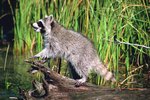
Raccoons (Procyon lotor) are some of the most physically distinctive wildlife around, with their memorable darkly masked visages; thick, ringed tails; and frequently rotund, squat physiques. The furry mammals are hard to miss, often seen right next to human establishments, usually busily looking around for their next meals.
Basic Information
Raccoons generally have brown, reddish-brown or gray coats. Mature raccoons usually grow to anywhere between 24 inches and 38 inches long. Weightwise, these creatures tend to be between 14 and 23 pounds. Female raccoons are generally smaller than males. Raccoons can adjust easily to many different types of living environments. Not only are they fixtures in damp woodsy areas, swamps and meadows, they also are abundant in urban settings. Nearby water is a must for their successful survival.
Raccoon Diet
These omnivores are far from picky eaters, as they practice opportunistic dining styles. A lot of what raccoons consume is directly influenced by what's around them. Some of the forms of sustenance that raccoons routinely feast on include fruit, vegetables, nuts, seeds, other plants, amphibians, fowl, clams, snails, carrion, bugs, rodents, slugs, worms, crayfish and eggs from both reptiles and birds. Sweet corn specifically is a raccoon preference. It isn't uncommon for raccoons to scour for food amidst human trash. They also frequently eat pet food that is left outdoors.
Eating Patterns
Most raccoon feeding takes place in the nighttime, as they are nocturnal creatures. Daytime endeavors are rare for them. Raccoons forage with the assistance of their lengthy fingers and speedy, skillful paws. When raccoons are close to bodies of water, they frequently immerse their findings in it -- a means of simultaneously checking for random things that might be stuck on the food, and also of making the sustenance have a smoother texture. When no water is to be found, however, they abandon this behavior. As far as lifestyle goes, raccoons are usually pretty independent. If a lot of food is accessible in a specific spot, however, you might find lots of raccoons congregating together.
Avoiding Feeding Raccoons
If you have raccoons around your home, offering them food might not be a safe option -- not only for your household, but for the rest of the people in your neighborhood. When raccoons receive food from people, they become extremely relaxed in the presence of humans. When the raccoons don't get the food they want, however, they sometimes turn fierce in behavior. Be smart and safe. Don't allow this scenario to happen.
References
- PBS Nature: Raccoon Nation
- National Geographic: Raccoon
- New York State Department of Environmental Conservation: Raccoon
- Wisconsin Department of Natural Resources: Raccoon
- NatureWorks: Raccoon
- Indiana Department of Natural Resources: Raccoon
- Washington Department of Fish & Wildlife: Raccoons
- University of Michigan Animal Diversity Web: Procyon lotor
- Minnesota Department of Natural Resources: Raccoon
Photo Credits
-
Jupiterimages/Photos.com/Getty Images




